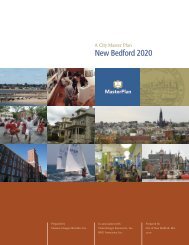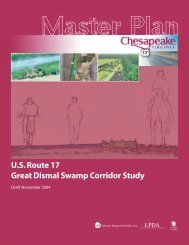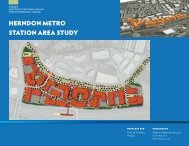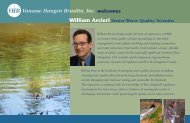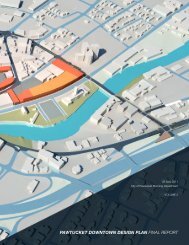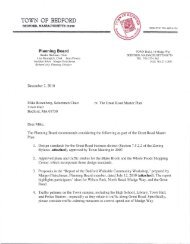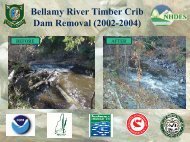Final Report - VHB.com
Final Report - VHB.com
Final Report - VHB.com
You also want an ePaper? Increase the reach of your titles
YUMPU automatically turns print PDFs into web optimized ePapers that Google loves.
etaining a signalized intersection at this location, which is projected to operate at<br />
LOS D or better <strong>com</strong>pared to LOS F under No Action.<br />
Similar to the Church Street intersection, Option 1 calls for a new roundabout at the<br />
intersection of Pleasant Street and River Road/Webster Street, whereas Options 2<br />
and 3 call for retaining traffic-signal control. The roundabout is projected to operate<br />
at LOS E but improve to LOS D with the aggressive TDM program. The signalized<br />
intersection is projected to operate at LOS C for both Options 2 and 3 with and<br />
without TDM.<br />
Options 1 and 1A substantially meet the objectives of improving mobility, enhancing<br />
safety, ac<strong>com</strong>modating NASB travel demands, and dovetailing with <strong>com</strong>munity<br />
goals but only moderately meet the objective of encouraging multimodal mobility.<br />
Options 2 and 2A meet the objectives at a similar level except for dovetailing with<br />
<strong>com</strong>munity goals, which was rated as moderately meeting that objective. Option 3,<br />
the five-lane cross-section, substantially improves mobility and substantially<br />
ac<strong>com</strong>modates NASB travel demand, moderately enhances safety, but only<br />
minimally encourages multimodal mobility and dovetails with <strong>com</strong>munity goals.<br />
Environmental Impacts<br />
Strategy 2B, which is defined by the Pleasant Street (US Route 1) corridor from Exit<br />
31 to Mill Street, currently exists as an urbanized landscape with limited natural<br />
resources present in the strategy area. The footprints associated with Options 1 and 2<br />
are identical along Pleasant Street, except at the intersections of Church Road and<br />
River Road, where Option 1 calls for roundabouts and Option 2 calls for traffic<br />
signals. Option 3 requires the least amount of new pavement (i.e., 7.8 acres) and<br />
causes the least environmental impact.<br />
Environmental Resources<br />
As previously mentioned, limited natural resources exist in the strategy area, and<br />
those present are located along the margins of the Study Area. For example, based on<br />
current concept plans and current mapping, wetlands and stream impacts are<br />
expected to be negligible.<br />
The potential water-quality impacts are similar among all options because each<br />
requires a similar amount of new pavement, ranging from 7.8 acres (Option 3) to 9.2<br />
acres (Option 2A). All of the options would similarly impact two areas of Zone AE<br />
floodplains associated with two unnamed perennial streams, totaling 0.2 acre.<br />
Furthermore, each option would impact a similar amount of the sand and gravel<br />
aquifer, ranging from 3.9 acres (Option 3) to 5.7 acres (Options 1A and 2A).<br />
More important, there are a substantial number of potential hazardous-material sites<br />
present within the corridor that would need to be considered as part of the<br />
construction for any option. Each option could impact at least 10 known hazardousmaterial<br />
sites, many of them underground petroleum tanks. Although each site<br />
Conclusions 155



